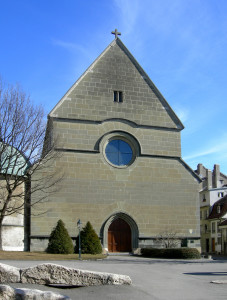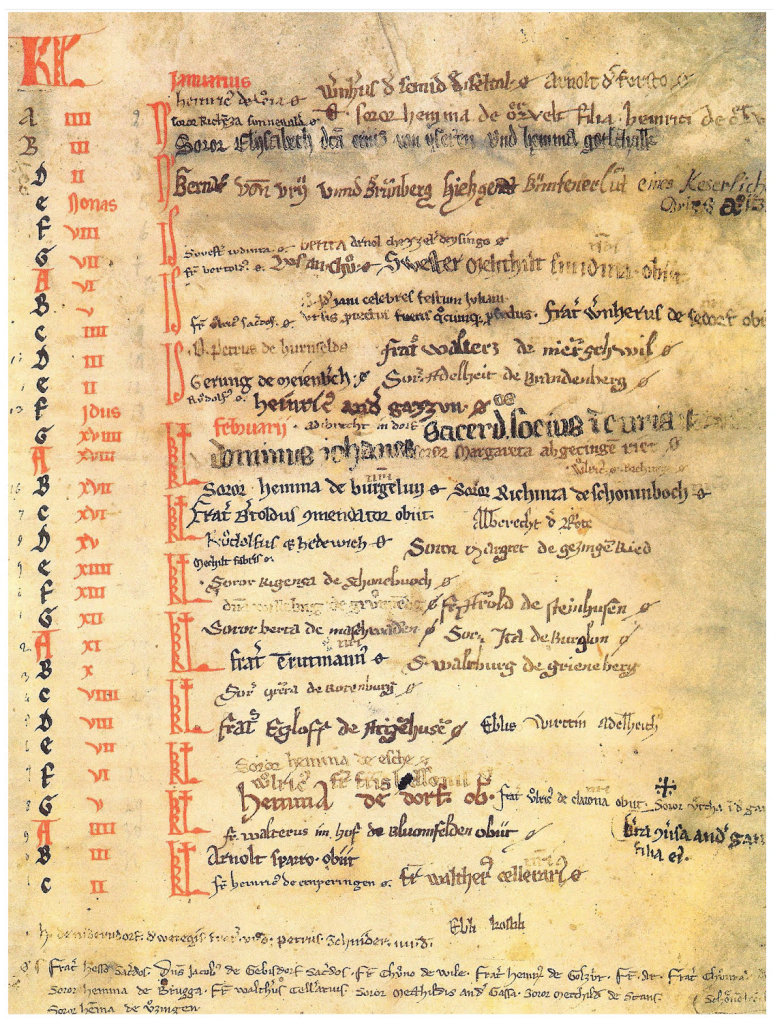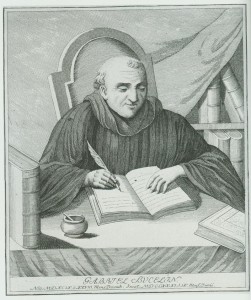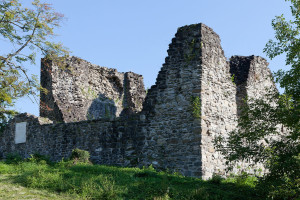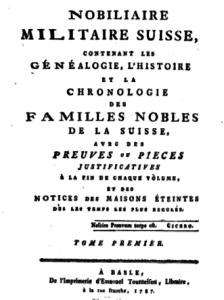, who would later become the chief archivist of the city of Lucerne, wrote a detailed history of the Barons of Attinghausen and Schweinsberg (from whom the
).
Theodor Von Liebenau was from a much later generation of historians than Jean-François Girard who wrote the Nobiliaire Militaire Suisse, which contains one of the oldest histories of the Zumbrunnen family. There are both benefits and drawbacks from relying on historians of this later period. Von Liebenau was much more scientific and critical than earlier historians, who sometimes used unreliable sources. But he also wrote his work after many of the original documents had been lost — a fact he himself acknowledges.
The most famous Attinghausens are not ancestors of the Zumbrunnen. Rather, they were the cousins of our earliest ancestors. But the first chapter of Von Liebenau’s history covers the oldest barons of Attinghausen, some of our ancestors from the oldest mists of the Middle Ages.
I. The Oldest Barons of Attinghausen
In the first half of the fifth century after Christ’s birth, the tribe of the Alemmani, from Swabia, entered the Roman-controlled lands of Switzerland, and took possession of the land of Uri through armed conquest. At that time, the land around the lake of the forest states was no longer wilderness, as numerous coin finds tell us.
It is therefore not unbelievable that one of these conquerors, who divided up the land they had conquered, was given a plot of land in the country of Uri, in the region where the forest joins the Reuss river and whose descendants, in much later times, built a mighty fortress which was named after its builder — Atto or Hatto — and was called Attinghausen.
This hypothesis is not affected by the fact that Attinghausen is not enumerated among the towns in Uri, which were given by the Carolingian King Ludwig the German to the abbey of Zurich. At that time there was no other kind of nobility in Attinghausen.
They became the family of the Barons of Attinghausen, the only one of the higher nobility who lived in Uri. (There are two theories about the origins of the Barons of Attinghausen; this is some of the evidence that they are an ancient family of Uri.) They distinguished themselves especially with the possession of great commodities and a considerable number of serfs, as we can see from the records of the late period. Unfortunately, only a few documents bear witness to the existence of this ancient family. These are the old walls of the castle, and some notes in the Yearbooks of Attinghausen. (These yearbooks, also called Necrologies, were calendar books kept by churches that recorded the date of death of wealthy benefactors so that the priests would pray for them each year. They are a key source for ancient genealogies.)
Determining the age of the walls of the Attinghausen Castle is extremely difficult. The assumption is that the castle of Attinghausen, whose windows show round arches, was rebuilt and fortified after the first half of the twelfth century. It was in 1162 when Emperor Frederick I destroyed the city of Milan after a long siege and brought rich booty to Germany. It is possible that one of the Barons of Attinghausen was with the King in Italy — where the siege gave energetic men a splendid opportunity to prove their bravery — and they were entrusted by the emperor with the honorable commission, the Gotthard Pass. The castle of Attinghausen was very well situated, especially as the old Gotthard Road stretched along the left bank of the Reuss River.
Due to a lack of documents it is no longer possible to determine who was this vassal of Attinghausen for Frederick I. We know only the following names of Attinghausen’s earliest barons: Heinrich, Albrecht and Lamprecht, and of women: Bertha and Othilia, the latter being buried in the Lazerite monastery at Seedorf.
The barons further enriched themselves through a heiress of the House of Löwenstein, Richenza was her name. They glorified her name by means of renumerations to the church at Attinghausen, and ended her tribe of Löwensteins. They also came into possession, possibly through a heiress, to the Barony of Schweinsberg.
This information does not all come from contemporaneous data. It is nevertheless possible that two old scholars: Franz Vinzenz Schmid and Jean-François Girard may have drawn their reports from older writers who were lost at the fire of Altdorf.
The House of Löwenstein was later found to be in the possession of the Zumbrunnnen Family, which still lived in Tuscany in the last century, and who uncritical genealogists like Gabriel Bucelin also say descend from the Barons of Attinghausen.(Some Zumbrunnen lived in Parma, Italy in the 1700s. While Bucelin may have been an “uncritical genealogist” in some cases, his genealogy of the Zumbrunnen family from the 1600s is actually quite accurate.)
The Barons of Schweinsberg originally lived in the Bavarian Alps, in the regions of Tegernsee and Tyrol. Often their names are found in the “Codex Traditionum” of the Tegernsee Abbey, founded between the Isar River and the Inn River, around the year 700 by Albert and Ottoger, Earls of Warngau and Tegernsee.
From about 1140 to 1150, Wernher von Schweinsberg appears several times with his father Gerwich. Wernher had a son named Gervich and a brother Wolftregil. When Frederick I was in Würzburg in 1157, he was with Kraft Von Schweinsberg. One can also find a Castle Schweinberg near Hardheim am Main; the owners of this castle also possessed a Castle Löwenstein. The Schweinsberg, who lived in Franconia, would later be called Count Von Wertheim. The most prominent names of this family are: Erlewein, Conrad, Heinrich, Hermann, Johann, Reiner and Wernher. The family known as Von Schweinsberg, which still lives today in Darmstadt, is very well known. The fact that the Barons von Schweinsberg really moved away from Tegernsee is confirmed by the fact that their names are not mentioned in any later document of this monastery.
Even the name of Wernher von Attinghausen, which occurs multiple times (The key challenge untangling the genealogy of this family is the large number of people at the time who were all named Werner.), and which is also found in the lands of the Barons of Schweinsberg, indicates a kinship between the two families. But the immigration of these barons into our country is credible for other reasons.
In 1156, Henry II, of the House of Babenberg, handed over Bavaria and Austria to Emperor Frederick I, who handed over the duchy to Henry the Lion. The land where the Barons of Schweinsberg lived, turned into a duchy, which should be hereditary for both male and female lines of the house of Babenberg.(In short: the Barons of Schweinsberg lost their original lands in Bavaria as part of a land swap that was designed to avert conflict.)
When the emperor took his second trip to Italy, and destroyed Milan in 1162, the duke of Austria was with him and so was Baron Von Schweinsberg. During this campaign, the Barons of Schweinsberg became friends with the Barons of Attinghausen, and were given estates by the emperor in the Emmental Valley, where they built a castle.(This seems to be a reference to Castle Wartenstein)
Of course, we can make this assertion with documentary support; On the other hand, it is very easy to prove that in these days, many other families migrated from Bavaria and Austria to Switzerland. We recall here, for example, the families of Utzigen and Wilbeck, of Trostberg, whose castle was situated in the Chiemgau, where Traun fell into the Alza, and to that of Noberg, whose castle was almost the same as the old castle of Trostberg: In the Aargau, in Uri, and in the gorges of the Jura.
After these barons of Schweinsberg (perhaps at the beginning of the thirteenth century) had entered the estates of Attinghausen by means of inheritance, they took the name of Attinghausen. Throughout the 14th century they called themselves, in seals and letters, sometimes Von Schweinsberg, sometimes Von Attinghausen.
Probably the first of the Barons of Schweinsberg who settled in Uri is in the “Directorium Cantus” of the Benedictine monastery of Engelberg. It is beginning with Lord Ulrich that we securely know the order of the Barons of Attinghausen, who always enjoyed special respect.
It is the task of the following pages to illustrate the history of this glorious house, which at a later time was divided into one line in Uri and one line in the Emmental, near Bern. The pages will especially focus on the line which was situated in Uri.
A man stands where he is born and as his spirit first develops, he unconsciously interacts with the rippling waters and shale of his country in a constant and intimate process. For men do not educate their children alone. The mountains and valleys, forests and corridors, streams and seas, nature and climate, in their entire splendid change, and no less in times of storms or in the peaceful course of their events, form and shape the man to what he is and shall be, according to the power of the spirit that lives in him.(Poetic!)
